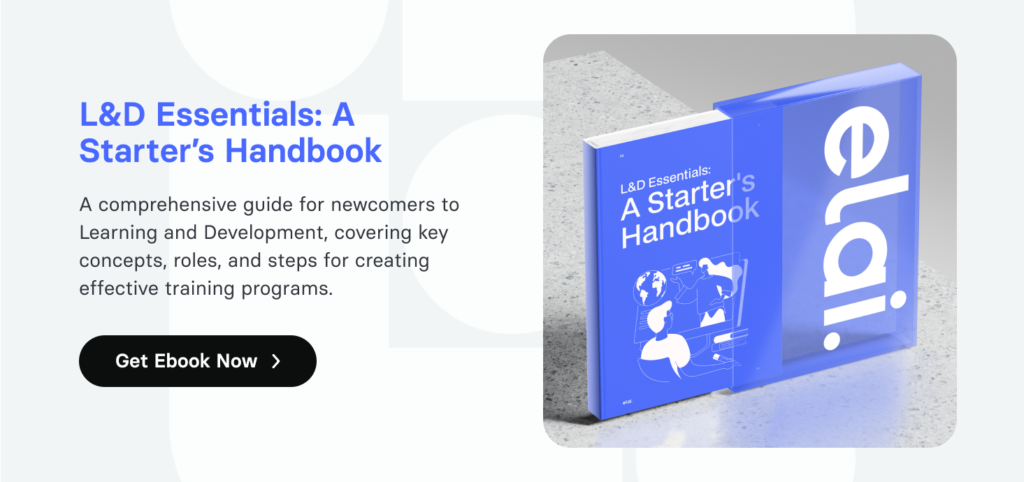The term “hybrid” is usually associated with innovation and revolution as it combines several approaches or properties while covering the needs, preferences, and requirements of most parties and circumstances. And modern education was no exception. In modern e-learning practices, hybrid learning has become a powerful tool that combines the traditional in-person classroom experience with the flexibility and accessibility of online learning. The benefits of hybrid learning aid organizations embody and enhance their learning and development initiatives efficiently and productively. The report proves that 73% of learners experience better work-life balance after implementing hybrid learning into their learning practices and almost all the participants improved their time management skills.
But what is hybrid learning? This is a combination of traditional learning and e-learning training that cares for the varied needs of learners as well as organizations. The hybrid learning model is intended to be a better way for learners to learn, it encourages them to take initiative in their education. The increasing presence of hybrid learning makes it the most effective solution for constructing an accommodating, individualized, resourceful, all-encompassing, and budget-friendly learning environment.
The Evolution of Hybrid Learning
Hybrid learning is a teaching approach that consists of face-to-face interactions and online learning practices that have become widespread and gained huge popularity in recent years. The hybrid learning definition demonstrates that this pedagogical approach emerged as a result of the appearance and influence of many evolutionary-historical developments and factors (socio-political, epidemiological, educational) and is now considered an indispensable means of promoting truly effective quality education, considering that traditional methods no longer have a place in modern conditions.
From technological advancements to the global impact of the COVID-19 pandemic… The reasons for the appearance and wide application of hybrid learning might be different.
The concept of online education, where students learn from a distance without physical presence in a traditional classroom, can be traced back to the early 19th century. Through remote learning, with the help of correspondence courses and radio broadcasts, people delivered education from one place to another. At the end of the 20th century, distance and face-to-face learning can be combined to provide a form of personalized location-based tuition for course materials, with participants able to use course material outside class at their convenience or complete assessments remotely whilst still participating in face-to-face class sessions.
Hybrid learning is becoming more and more popular due to the development of robust learning management systems and learning resources. The widespread online learning resources—discussion forums, online quizzes, and video conferencing capabilities—are helping to continue providing a high-quality education that is interruption-free (something not achievable with the traditional approach). Hybrid learners can be living anywhere in the world as long as they have access to technology to communicate and share their documents, broadcasting what they are doing without hesitation. Hybrid learning meaning became a buzzword during the COVID-19 period after educational institutions all over the world all of a sudden had to transition to online learning practically overnight, triggering an increase in hybrid learning model implementations. This was also solid proof that hybrid learning could deliver the kind of education experience even more institutions started to incorporate hybrid learning directly into their overarching educational strategy. Based on the research of the Institute for the Future of Education, 9.5 out of 10 learners are considered to be more satisfied with elearning practices as it keeps them engaged and helps them retain information better.
By highlighting the flexibility, accessibility, and effectiveness of online and blended learning models, it has helped to solidify the position of hybrid learning as a viable and valuable approach to education.
Key Components of Effective Hybrid Learning
To ensure hybrid learning effectiveness, several key components must be in place:
- Learning Design:
- Curriculum development (in-person and online components align seamlessly with overall learning objectives, leveraging their strengths)
- Learning objectives and outcomes (clearly define specific learning objectives and develop assessment methods that accurately measure their achievement)
- Instructional strategies (employ a mix of synchronous and asynchronous activities to cater to different learning styles and preferences)
- Technology Integration:
- Selection of appropriate LMS and tools (choose an LMS that supports the specific needs of hybrid learning, including all essential features)
- Integration of technology into the learning experience (integrate technology into the curriculum and instructional strategies properly)
- Ensuring accessibility and usability (design the learning experience with accessibility in mind, considering the needs of learners with disabilities)
- Facilitator Role:
- Hybrid facilitator skills (strong skills in both online and in-person facilitation, including effective communication, engagement, and management of virtual spaces)
- Creating a supportive learning environment (foster a sense of respectful and inclusive community and belonging among both in-person and online learners)
- Managing both in-person and online interactions (manage both in-person and online interactions, ensuring smooth transitions and coordination, keeping all learners engaged)
- Learner Engagement:
- Strategies for maintaining engagement in both settings (offer a variety of activities and learning experiences to keep learners interested)
- Personalized learning experiences (offer personalized support and guidance to learners based on their needs and learning styles)
- Collaborative activities and peer-to-peer learning (encourage collaborative activities that promote peer-to-peer learning and teamwork)
Hybrid Learning vs Blended Learning: Difference
Blended learning and hybrid learning are often used interchangeably, but there’s a slight difference.
Blended learning is a more general term that includes any mixture of face-to-face instruction and online learning.
Hybrid learning is a rather well-defined form of blended learning in which students attend class in person and online on a fixed schedule.
In essence, hybrid learning is a subset of blended learning.
Challenges and Opportunities in Hybrid Learning
Although it is one of the most efficient learning methods nowadays, there are still pros and cons in the application of hybrid learning in the learning process. If addressed and engaged correctly, then the challenges hybrid learning faces in front of it open doors to limitless opportunities and can become a medium for providing a genuinely equitable, flexible, and authentic (to student) experience.
- Challenges:
- Technological barriers: Unstable internet connection, device limitations, or lack of access and skills to technology
- Equity and accessibility issues: Accommodations for students with disabilities and limited access to reliable internet may be difficult to ensure in a hybrid learning environment.
- Maintaining a continuous learning experience: It might seem difficult to keep all students engaged and motivated while maintaining consistency in the quality of learning opportunities no matter where the learners may be.
- Opportunities:
- Personalized learning at scale: Teachers can offer more personalized attention to students with the help of hybrid learning in terms of their needs and pace. Similarly, various tools and platforms allow for the personalization of content and instruction according to specific learning needs.
- Greater flexibility and accessibility: The hybrid learning model can provide distance learning opportunities, such as flexible scheduling and personalized study arrangements, for students who may not be suited to traditional in-person learning.
- Global collaboration and knowledge sharing: Hybrid learning allows not only students to collaborate with teachers who live and work halfway around the world; it encourages global coming together, shaping an international mindset in the student. The virtual platform allows learners and educators to connect over all of these sharing assets, ideas, and best practices.
How to Address the Challenges and Utilize Hybrid Learning Benefits
To successfully implement hybrid learning, it is essential to address the challenges and leverage the opportunities. This requires:
- Constant access to reliable tools and internet connection
- Professional development for facilitators with the necessary training and support
- Equity initiatives to ensure accessibility for all students
- Engaging and adaptive curriculum design
- Assessment and evaluation to measure student learning and progress
- Collaboration and partnerships between educational institutions and organizations to share resources and best practices
Future Trends in Hybrid Learning
Driven by technological advancements and changing learner needs, modern education is constantly evolving. As we look ahead, hybrid learning examples based on emerging trends are poised to shape the future of hybrid learning.
VR, AR, and AI
Virtual reality, augmented reality, and artificial intelligence can change the way we learn forever. It can provide hands-on experiences that are hard to replicate inside a traditional classroom or would be dangerous as well. AI-based tools can further personalize learning experiences by adjusting to individual learners’ needs, and their pace. For those students who do require extra help, something that an intelligent tutoring system can personalize for those needs, and the AI-embedded analytics will help teachers identify where they may be struggling.
Microlearning
Microlearning, turned into small, digestible chunks, can be easily simplified and delivered for easy consumption amongst the learners when they want to access them. In addition, microlearning is a great thought to reinforce just-in-time learning — enabling learners to access on-point information when they need it. Educators can use the individual interests, needs, and learning styles of a learner to modify learning experiences in ways that increase participation and result in improved outcomes.
Hybrid Learning in the Workplace: Performance Support and Upskilling
Hybrid learning has changed modern workplaces a lot. Performance support provides employees with the information and resources they need to perform their jobs effectively. By blending digital resources with traditional training, companies can ensure employees have the information and knowledge to be retained. It helps the employees to stay up-to-date with industry trends and ready them for future roles by developing new skills or upgrading existing ones.
Utilizing new and emerging tech along with microlearning, personalization, and hybrid workplace learning strategies can help make that experience unbelievable and effective for learners of all ages and backgrounds.
Conclusion
In other words, hybrid learning is a novel method for educational accomplishments and a kind of forced step (as an answer to the educational realities of the present time) that has evolved into a full-fledged alternative to traditional teaching. Overall, the right implementation of hybrid learning, will be beneficial and lead to a meaningful, successful, and inclusive educational environment.
FAQ
What is hybrid learning?
Hybrid learning combines traditional in-person learning with online education to meet diverse learner needs and preferences, offering flexibility and improved time management.
What is the difference between blended and hybrid learning?
Blended learning is a general mix of online and face-to-face learning, while hybrid learning is a specific format where students attend both in-person and online classes on a set schedule.
What are the five elements of hybrid learning?
- Learning Design
- Technology Integration
- Facilitator Role
- Learner Engagement
- Accessibility and Equity

